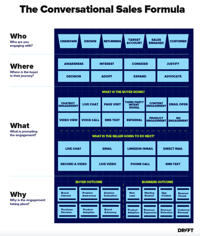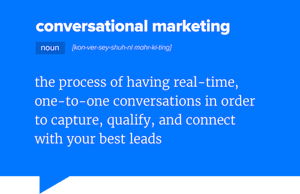Tl;dr - Industrial manufacturers might not recognize the conversational marketing trend until they've already allowed friction to develop with prospects and website visitors. While we can't chase every shiny object, conversational marketing is something that will improve customer interactions with rising generations of business buyers.
Disruption Isn't Linear
Most companies watch known competitors to look for new models, features and integrations.
That makes sense...if you believe that the future is a linear extension of the past. In other words, if the competitor that might be your biggest future challenge is one of those that vexes you today; and if the innovative solution that tomorrow's customers will embrace is an adaptation of one you use today.
Except that's not how most companies rise to their prominence, much less preeminence, in an industry.
More often there's a substantial change - for instance an entirely new category of equipment, or a radically different business model (like PaaS) that interrupts the linear evolution and catches industry stalwarts unawares.
Transformation doesn't need to be linear either
 Manufacturing companies are inherently linear. Products get visualized, prototyped, then manufactured. Materials come in one end of the factory and finished goods leave from the other. Process gets dissected step-by-step in pursuit of improvement.
Manufacturing companies are inherently linear. Products get visualized, prototyped, then manufactured. Materials come in one end of the factory and finished goods leave from the other. Process gets dissected step-by-step in pursuit of improvement.
That's valuable where it provides structure for consistent improvement and quality, but it's a liability when it interferes with adaptation.
And a startling number of companies which are meticulous about monitoring metrics in manufacturing are quite cavalier about analogous opportunities on the front-end of the business. For instance hesitating to implement CRM or marketing automation because "we've never used that and our people would be uncomfortable with the change."

You still use a fax?
An example about which we can probably all chuckle is the lingering presence of fax numbers on business cards and websites.
Seriously?
At least most of the machines were upgraded from rolls of coded paper to plain paper sheet fed mechanisms some years ago. But the persistence as a communications mode defies both practicality and efficiency.
An anchor
 Except...it's not really funny. It illustrates the problem with linear adaptation. Today letters & proposals should be delivered with technology that provides tracking metrics around opens, reads, shares and even online secure execution of agreements with integrated payment options.
Except...it's not really funny. It illustrates the problem with linear adaptation. Today letters & proposals should be delivered with technology that provides tracking metrics around opens, reads, shares and even online secure execution of agreements with integrated payment options.
That's at least an email step removed and possible further.
Yet the fax machine "mentality" anchors companies' expectation. That is inconvenient for prospects and customers in the near term, and it confounds buyer expectations in the longer term.
The trend toward conversational marketing is a great example.
Live chat evolves into conversational sales
 Most people in the B2B sales space are aware of having seen live chat. Some have engaged. Often the exposure is only in their role as consumers because few B2B industrial companies have yet implemented the technology.
Most people in the B2B sales space are aware of having seen live chat. Some have engaged. Often the exposure is only in their role as consumers because few B2B industrial companies have yet implemented the technology.
Particularly fascinating (and perhaps telling) is the evolution I've seen a couple times as B2B complex sales companies have tried it.
It works. In fact it works so well that buyers (you know the ones whom you're not sure how much they really use your website) engage: consistently and vigorously. And the engagement reflects the entire buyer experience - awareness, consideration and decision stage prospects, existing customers and tech support.
Here's the rub. I've seen experiments terminated and pilots ended...because it worked so well. Rationals include:
- It took too much time
- We didn't know how to answer all the questions
- We don't have time to create a routing system for inquiries to other departments
Think about this for a second. If your switchboard was flooded with calls would you unplug the phone line? Of course not. You'd figure out how to answer, route and satisfy the callers.
Why are these conversations any different? Clearly they're not for the customers....they're only different for the seller. And the difference is in the anchoring effect and expectation of linear adaptation.
Conversational marketing, sales & service
 Is a website owned by IT? By marketing?
Is a website owned by IT? By marketing?
Although the latter is vastly preferable to the former, the mindset that it's solely resident with one function or phase in the customer experience is faulty. It leads to the expectation that live chat is a marketing function, to be staffed and supported by small staffs focused on graphic design, trade show planning and content creation.
Your prospects, buyers and customers DON'T CARE about your organizational silos. They want to speak to someone who can answer their questions and provide insights. You've almost certainly packed your website with all your specs and data sheets...so anyone who's contacting you wants more than simple info. They expect expertise.
And without exception, every sales team with whom I speak laments the difficulty they have connecting with prospects and customers for meaningful conversations.
And yet....live chat is ignored.
It's time to change that, and industrial companies have an opportunity to be early adopters - pioneers almost.
Live chat has become an effective tool for conversational marketing and is quickly branching into conversational sales and conversational service. It can help all your website visitors to quickly connect with the information and resources they need. That improves customer support as much as marketing and sales. Personalized experiences are natural and comfortable for prospects and customers, and become a competitive edge for manufacturers efforts to drive revenue growth.
It's not some grueling IT project
The technology is easily implemented - not only to put the tools on a website, including natural mobile optimization - but also to naturally route and transfer inquiries, to set on/off duty or availability, to respond appropriately by page content and more.
In fact the conversion forms which have become increasingly common in recent years are gradually giving way to chat, often with quick multiple choice questions for lead qualification and customer routing.
Affordable and intelligent bots are readily available. I'll grant that the marketing team that canned chat because it was too successful did spend a lot of time answering the same questions repeatedly. Easily programmed and conversational bots are easily implemented and help visitors quickly get the answers to the typical 20% of queries which constitute 80% of the interactions. Seamless transfer from bot to human is easy - so visitors aren't frustrated with experiences like the auto phone attendants which are the stuff of comedy shows.
And the technology is reasonably priced.
Solving for buyers
Behind decisions like this lies a fundamental mindset question. Is your company naturally inclined to establish your framework and then try to guide customers accordingly...or do you solve for customer/buyer/prospect expectations and build your experience around them?
That's likely emerging as the single most important predictor of competitive success.
Is conversational marketing or sales the acid test for that? No. But it's a representative example and could be indicative of mindset.
And as technology improves, then implementation becomes important. Simply popping up windows becomes clumsy, but succinct and effective copy enhances the visitors' experience and your results. (In fact, a couple folks have already staked out ground in this space as experts in effective implementation. Anyone can plug in the code, but Chris Handy of ClosedWon is actually helping to create the "user manual.")
If you're interested in learning about how conversational sales, service or marketing could enhance your buyers' experience and improve your results....well, then you know what's coming. Let's chat!
Diving Deeper into the Road Ahead for Conversational Marketing Strategies in Manufacturing Revenue Growth
As conversational marketing evolves it's important to understand emerging trends like AI-powered chatbots, voice search. Increasingly, leveraging chatbots is essential for businesses striving to stay ahead. These innovations are not just technological advancements; they are reshaping the way companies interact with their customers, driving sales and customer engagement to new heights.
The Importance of Client Data and Customer Preferences
At the heart of effective conversational marketing lies a deep understanding of client data and customer preferences. By analyzing engagement and purchase history and customer interactions across various channels, businesses can tailor their strategies to meet the unique needs of website visitors, prospects and customers. This data-driven approach ensures that every conversation, whether through human agents or chatbot interactions, adds value to the customer experience.
The bottom line is that for many customers, conversational marketing and chatbots are their preferred method of communication and engagement, and failing to provide it actually disadvantages the industrial sales team.
Leveraging Chatbots and AI in Customer Support
AI-powered chatbots becoming a powerful tool in customer support and prospect engagement. These bots are capable of handling multiple channels simultaneously, providing quick and efficient responses to customer queries. This not only enhances the customer experience but also frees up human agents to handle more complex issues, ensuring a balanced approach to customer service.
Great conversational marketing offers easy options for engaging with bots or quickly moving to live connection. Live chat can also move quickly to live video and meetings.
Human Interaction: The Key to Engaging Experiences
Technology isn't always the answer alone - the importance of human interaction in the digital age cannot be overstated. Customers crave engaging experiences that feel personal and human. Businesses should aim to create a blend of human and AI interactions, ensuring that customers feel heard and valued. Combining the efficiency of chatbots with the empathy of human agents, this two-way conversation approach leads to more informed decisions and a deeper connection with the brand.
Voice Search and Multiple Channels: The New Frontiers
Voice search is rapidly becoming a preferred method for many users, especially in the context of conversational content. Adapting to this trend means businesses can offer more convenient and accessible ways for customers to interact with them. Furthermore, the use of multiple channels for customer interaction, including social media, email, live chat, SMS, video, and voice, ensures that businesses meet customers where they are, offering seamless and cohesive experiences.
Driving Innovation and Sales in the Digital Age
In the digital age, driving sales is intricately linked to how well a business adapts to and incorporates the latest technological trends. AI-powered chatbots and smart data collection strategies are not just about handling customer queries; they are about understanding customer needs and preferences, which in turn drives innovation in product and service offerings.
The Immense Potential of Conversational Marketing
Conversational marketing holds immense potential for businesses looking to enhance their customer engagement strategies. By leveraging chatbots and other AI tools, companies can provide more engaging experiences, driving sales and building stronger customer relationships. This approach is not just about adopting new technologies; it's about understanding and utilizing these tools to create meaningful and lasting connections with customers.
The Growing Impact of Conversational Marketing on Manufacturing Marketing Best Practices
As technology continues to evolve, businesses must adapt to stay relevant. Conversational marketing, driven by AI and a deep understanding of customer preferences, is becoming a critical component of successful business strategies. By harnessing the power of data, engaging in meaningful two-way conversations, and creating added value through every interaction, businesses can unlock the full potential of these tools. The future of marketing is conversational, and those who embrace it will find themselves at the forefront of driving innovation and customer satisfaction.


